




x #06
Jul.08

|
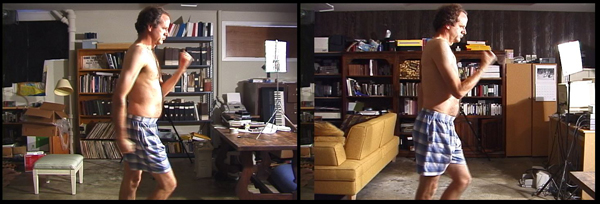
Scott Stark in “Shape Shift” (2004, miniDV, color/sound,
10 mins)
“I’m very interested in accidents, imperfection,
random events, things happening that I never could predict. I like
to set up a situation, give it some parameters, and see what happens.”
Scott
Stark, July 2008
About Scott Stark
Stark is a brilliant filmmaker with a long list of
movies and a Guggenheim award to his credit. Earlier this year, Stark
put together a repertoire for a screening, was part of a new bimonthly
Avant Garde Cinema series, a bold initiative put forward by the Austin
Film Society as this is arguably one of the most obscure video art
genre. The auditorium was full though, and the evening was a rollercoaster
of emotions: from the nostalgia of the 70s (with ‘Angel Beach’
that we watched to the sounds of the Beach Boys) to the uncomfortable
sense of actuality with his ‘More Than Meets the Eye: Remaking
Jane Fonda’, where sequences of Scott's aerobics "moves"
are intertwined with Fonda's memorable statements against the Vietnam
war. Those statements are disturbingly relevant today.
Those who are privileged to know Scott can’t
stop wondering how this introverted and gentle man likes step out
of that character to challenge himself in front of the camera. He
defies security, surveillance, and convention by filming as he enters
Las Vegas Casinos (filming is forbidden there) with the sole purpose
of determining how far he can go before being stopped by the Casino
guards. I see a connection between his attempts of breaking through
the rules (particularly in public spaces such as airports - ‘Air’
- and malls - ‘To Live or to Die ‘) and his early movie
‘Degrees of Limitation’ - where he cranks
up an old camera by an increasing number of turns and leaves it running
as he climbs up a (typical) steep S. Francisco street. Each time we
see him going a little bit further away: in some of the sequences
there is some movement in the street : a couple watches, curious…
a bus starts its descent…a plastic bag dances in the breeze…
Stark makes the fear of ‘letting yourself go’,
crumble and leaves you “naked” with one thing: the stimulation
of your retina through beautiful stereographic images and unsettling
shifts of perspective.
Interview with Scott Stark
Ana Boa-Ventura: Unavoidable question
in an interview to be read mostly by digital arts aficionados:
what does your 16 mm camera offer you that a digital camera would
not? Do you see your use of the 16mm as a resistance to a universal
trend or does 'the digital' just not provide the effects you seek,
in your medium of expression? And if so, what are those effects?
Scott Stark: There are things I love about
both mediums; I try and exploit and explore what’s unique
about each. I like the physicality of film, and the fact that you’re
seeing an entire image at once rather than a series of scan lines.
When it’s projected, there’s something magical about
the quality of light as it passes through the air and hits the screen,
and the audience becomes a part of that; also there’s an awareness
that these same images are passing through the gate of a projector
somewhere behind you. It’s all very physical. Film is an object:
you can hold it in your hand and see the images, even without the
projector. Digital video, on the other hand, relies on a very complex
set of machinery to render it into something visual. I find that
this distances you from the source of the images. Finally, I’d
say that the image quality of film is superior to any digital image
I’ve seen, even high def, which to me often looks choppy and
too ‘contrasty’, with a much lower level of gradation
between colors and shades.
That said, I like the precision of digital – the way you can
precisely match up images and sounds and easily manipulate them,
creating very elaborate collages that are difficult – and very
expensive – to do in film. And you can work with time more
extensively – just let the camera run and see what happens.
Digital video captures a sense of place better than film.
For me, I’d say film is more about image quality, and video
is more about information. Also, film is about capturing what I’m
seeing while I’m filming, where video is about editing it
later, so there’s more of a distance between the source and
the final product. There are times when one or the other is more
important to me.
In the January 2008 screening of your work at the
Austin Film Society, you talked of your work as being about that place
we never quite get to… This was very striking in “Air”
and ‘Degrees of Limitation’… and, of course, in
the title you chose for that screening in Austin: “Getting Nowhere
Slow”. How do you see that place: virtual, impossible, subliminal?
Would you say this one of the preferred themes of your work? Tell
us about other themes that run through your work that now spreads
across 30 years.
That was an idea I came up with for that particular
show, based on the work I chose for it. I often reconfigure various
pieces of my work to have different meanings. I like the idea of
exploring “impossible” spaces – spaces which can
only exist cinematically – and spaces that people would never
consider inhabiting, though they might pass through it every day,
such as a 10-foot square stretch of freeway.
Other themes have to do with the body and sexuality, with transportation,
with war-making, with consumer culture, and sometimes combining
all of the above and seeing how they relate to each other. I like
to make my films and videos talk to each other.
Besides Michael Snow (to whose work 'Wavelength’
you acknowledge paying homage with a zoom-in on a painting
depicting the ocean), are there other video artists that you consider
a reference for your work or that you simply admire? Any honorable
mentions to digital artists?
Well… Ernie Gehr and Ken Jacobs have been
big influences in my life, but of course they were both filmmakers
long before they started working in digital. I do find that a lot
of digital artists nowadays get too carried away by the possibilities
of the technology – button pushing – so I can’t
think of too many that really inspire me. I have to say most of
the work that still inspires me is from makers still working in
some way with film, or the film apparatus.
You grew up in California and created much of your
work while living there. California has been a marker for many artists working
in various media. From Dennis Hopper’s 'Easy Rider' to Jack
Kerouac’s 'Big Sur' and even the HBO series 'Californication'.
Do you acknowledge that connection in your work? I am thinking of
‘Angel Beach’ – the golden Bridge – ‘Degrees
of Limitation’ - the steep street you insist in running
up while cranking your camera an increasing number of times or your
aerobics movements at your balcony in ‘More Than Meets
the Eye: Remaking Jane Fonda’. To what extent has California
shaped your work? To what extent does ‘where’ one lives
influence one’s work? Is ‘globalization’ changing
any of that, do you think?
I don’t feel any particular connection with
those works or any normal California culture. I will say though
that San Francisco has a fairly long and rich tradition of experimental
and avant garde cinema, and the work I made in my years there was
influenced and, in some ways, made possible by that tradition, especially
via the San Francisco Art Institute, where I studied film and developed
my own voice, and the San Francisco Cinematheque, where I first
began showing my work publicly. And also by the many other film
and video artists that lived and continue to live there, whom I
befriended and whose work I saw and was inspired by.
Beyond that, I certainly made a number of works that had something
to do with the world in which I lived and breathed, which was only
natural. But then many of those works were about places that might
be anywhere, such as shopping malls, parking lots, office buildings,
etc. Had I lived elsewhere in those years, some of them might have
looked somewhat different, but the ideas may have been the same.



Angel Beach – (2001), 16mm film, color, silent, 18 min
(Shown in the Whitney Biennial, 2002).
“Found 3D photographs of bikini-clad women from
the early 1970s are compressed into a two-dimensional cinematic
space, triggering an exuberant visual dance and revealing a troubling
and elegiac voyeurism”.
I have to say that ‘Angel Beach’ is
my favorite piece of yours. Would you tell us about the raw material
you used and the techniques involved?
I found a box of “stereo” 3D photographic
slides at a flea market, back in the late 1990s. The images were
mostly of girls in bikinis, taken by some guy with a 3D camera,
a camera containing two lenses, which are about the same distance
apart as human eyes. Typically you view the images in a special
viewing system so that your left eye sees only the left image, and
the right eye only the right; the effect is that the pictures look
three dimensional, since they’re taken from slightly different
perspectives.
Using a 16mm movie camera, I alternated the two images, frame by
frame, so that the perspective switches quickly back and forth between
the right and left perspectives. The result is a crazy kind of flickering
effect, where some objects seem still and others move quickly from
side to side. I then edited the pairs of images into sequences,
so the images become somewhat animated, but sometimes turn very
abstract, so that strange shapes begin to emerge. I find that most
fascinating – the way the human brain makes sense of all the
confusion by creating its own imagery.
The images are, of course, very voyeuristic and even disturbing.
I am sure you have heard of Second Life (SL).
How do you see the work of artists who are using it as a medium of
expression? Do you see it as one more medium of expression or just
a fad that will soon go away?
I have to admit I'm not really drawn to Second Life.
I find the real world interesting enough, and I spend way too much
time on the computer already to get sucked into a fake one.
Touché… I was addicted to
SL for a couple of years. Now I have developed (ahem…) more
self-control… Back to your work. Ok… I know we will
disagree on this one… I just love the Beach Boys soundtrack
you chose for Angel Beach in one of your screenings that I attended
– it took me immediately back to the 70s - striking colored bikinis
and impossibly beautiful bodies. But I understand that you think a
soundtrack takes back rather than adds to your work. If so, why?
Very often a soundtrack is used to tell you how to
think: when to feel sad, excited, happy, etc. I would rather have
sound and image exist separately from each other; in fact I like
people to think about the fact that sound and image are two separate
entities, that they can exist separately and we can put them together
in our experience to make something of them. Or not. Much of my
work is about creating a space for people to think for themselves,
to be open-ended, to not be told how to think. I don’t want
to direct their emotions. In the case of Angel Beach, usually I’ve
shown it silent; as an experiment, I played that same Beach Boys
song (“Warmth of the Sun”), one of their early lesser-known
pieces, over and over, so at first it was maybe a sensual, romantic
accompaniment, but then each time it becomes less so until it becomes
almost annoying. That makes you think about the constructed nature
of a sound/image experience like that, and about how you as an audience
member might be connecting those two elements in your mind which
really have nothing to do with each other.
Also, too often the use of sound is a trick; sometimes sound (such
as music) is put onto a boring image to mask the fact that it’s
uninteresting. It always works somehow; I find it too easy.
Since we’re talking about sound… what
are your tools? (and we want to know everything – camera, projector,
etc.) What software applications do you use in your work?
Well I’m using Final Cut Pro and a Sony digital
video camera for a lot of stuff. For my current film project I was
shooting a lot of 3D images using the same type of 35mm still camera
that that anonymous photographer used in Angel Beach, and then scanning
them into the computer to match them up and move them around. That
got to be very labor intensive, so I bought two digital still cameras,
built a mount so they could be side-by-side, and have been shooting
with that ever since, creating 3D images digitally. The image quality
is, I almost hate to admit it, better in digital that it was on
35mm slide film. I intend to output that to 35mm movie film when
I’m done. I’ve never made a 35mm film before.
I’ve worked with regular-8mm, super-8mm and 16mm film; I experimented
a lot with different ways of making films, such as putting movie
film in a still camera, and other wrong ways of doing it. In the
1990s I did a few high-8 videos, but I never liked that medium much
– the quality was terrible.
One of the most complex pieces you’ve created
is, for me, “I’ll Walk with God”. Would you describe
that piece yourself? Is that work about iconography, religion, none
of the above? How important is Mario Lanza’s voice on that piece?
For that film I took a few of those emergency procedure
cards that airlines stick in the seatback, and started rephotographing
the photographs on them, playing with editing and multiple exposures
to make them come alive. The images did seem rather spiritual to
me, almost like stations of the cross, once you took them out of
their original context. The faces of the female flight attendants
look relaxed, almost happy, something of course you wouldn’t
feel at all if you were on a plane going down. They reminded me
of those paintings with martyrs tied to a stake with arrows sticking
out of them; they had a look on their faces of sublime anguish,
as if they’d already passed to the next realm. Yes I was thinking
about them as religious iconography; giving it that title underscores
that. This is one of those few cases where I did put some music
to something; the Mario Lanza piece is so over the top, so over-emotional
that it almost becomes a parody of itself; yet it’s also amazingly
pure and beautiful. I think it allows you to find the imagery humorous,
but at the same time very moving and tragic. I think that says something
about the human condition, our will to survive, our ability to find
humor or humanness in tragedy.
In another presentation you did in Austin, you
had 2 projectors going. During the presentation you got up several
times, adjusting the speed of projector A or B creating just the right
lag you wanted between the two projectors. It reminded me of the DJs’
art of scratching. Would you characterize it like that? Would you
say your interaction with the piece as an author was one of looking
for imperfection?
That’s a good way of describing it. I’m
very interested in accidents, imperfection, random events, things
happening that I never could predict. I like to set up a situation,
give it some parameters, and see what happens. I never liked the
idea of creating a “message”; I like it when things
happen beyond my control, things that surprise me and create meanings
I never would have thought of. That's one thing I find difficult
when working with digital video and the computer everything's pretty
tightly controlled on a computer, and it's harder to create and
discover "accidents". That said, I actually wrote a little
computer script a few years back that would randomly edit video
sequences in Final Cut Pro. That allowed a level of randomness to
enter my working process. Often it resulted in nonsense, but occasionally
something really interesting would happen, something I'd never have
thought of on my own.
Links:
Scott Stark’s page on Hi-Beam:
Post about the Noema piece on Art Torrents:
Motion preview:
Watch the illustration of the technique Scott used
in Angel Beach at (requires Flash):
http://www.hi-beam.net/stretcher/ab_5.swf
Further Images:
[unless otherwise stated, all quotes are from artist
Scott Stark)
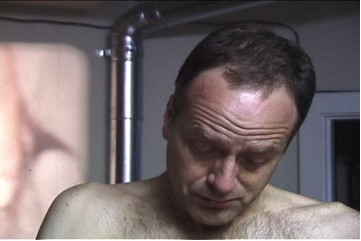
Chop – (2003), digital video, color, sound,
4 min.
“An insomnolent, self-mutilating, hydrophobic rendering of physical
and emotional anxiety.”
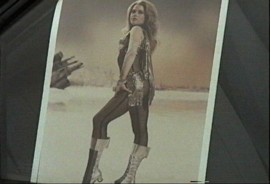
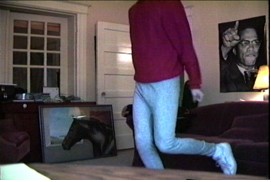
More Than Meets the Eye: Remaking Jane Fonda –
(2001/2006), Hi-8mm tape, color/sound, 20mins.
“…a remake of one of [Jane Fonda’s
aerobic] exercise videos […] By overlaying the diligent exercise
imagery with provocative and pointed quotations from Jane Fonda's
activist days, […] the remake gives voice to my own feelings
about the criminality of contemporary war-making and our own complicity
in a world that gives rise to a kind of cultural bulimia”.
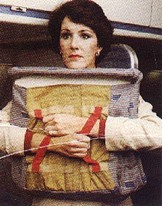
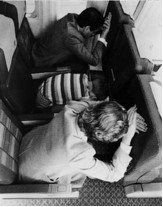
I’ll walk with God – (1994), 16mm color sound
film, 8:00 min
“Using emergency information cards surreptitiously
lifted from the backs of airline seats…”
Quote from Wheeler Winston Dixon: " "With the silence for
the first half, and the horrifying images, banal and tragic, sweeping
through the screen of the airplane crash cards, and then the Mario
Lanza track erupting on the sound level, the film summed up the ephemerality
of human existence, our collective wish to remain immortal, the impossibility
of this... it's a deeply felt, deeply moving film."
 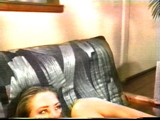
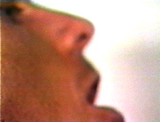 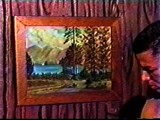
Noema - (1998) videotape (16mm film version
also available), color, sound, 11 mins.
“Pornographic videos are mined for the unerotic moments between
moments, when the actors are engaging in an awkward change of position
or when the camera pans meaningfully away from the urgent mechanisms
of sex up to a cheap painting on the wall or the distant embers of
a crackling fire.”
*Ana Boa-Ventura is a
Doctoral Candidate at the University of Texas at Austin
|